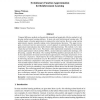Free Online Productivity Tools
i2Speak
i2Symbol
i2OCR
iTex2Img
iWeb2Print
iWeb2Shot
i2Type
iPdf2Split
iPdf2Merge
i2Bopomofo
i2Arabic
i2Style
i2Image
i2PDF
iLatex2Rtf
Sci2ools
CORR
2010
Springer
2010
Springer
Neuroevolutionary optimization
Temporal difference methods are theoretically grounded and empirically effective methods for addressing reinforcement learning problems. In most real-world reinforcement learning tasks, TD methods require a function approximator to represent the value function. However, using function approximators requires manually making crucial representational decisions. This paper investigates evolutionary function approximation, a novel approach to automatically selecting function approximator representations that enable efficient individual learning. This method evolves individuals that are better able to learn. We present a fully implemented instantiation of evolutionary function approximation which combines NEAT, a neuroevolutionary optimization technique, with Q-learning, a popular TD method. The resulting NEAT+Q algorithm automatically discovers effective representations for neural network function approximators. This paper also presents on-line evolutionary computation, which improves the ...
CORR 2010 | Education | Evolutionary Function Approximation | Function Approximators | Neural Network Function |
| Added | 09 Dec 2010 |
| Updated | 09 Dec 2010 |
| Type | Journal |
| Year | 2010 |
| Where | CORR |
| Authors | Eva Volná |
Comments (0)

